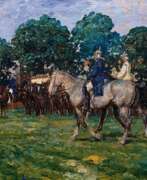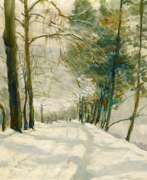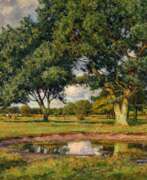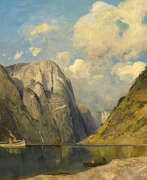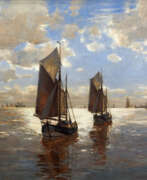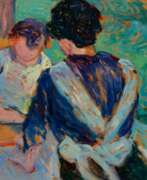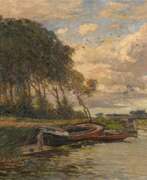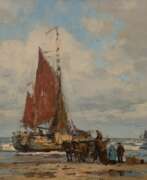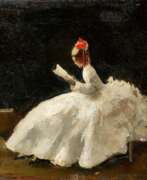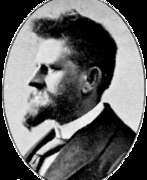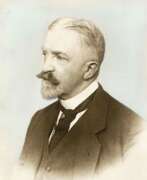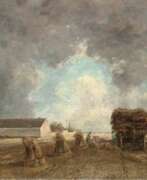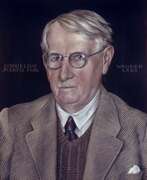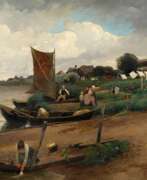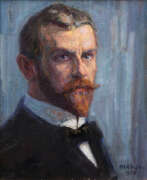Impressionism Düsseldorf school of painting
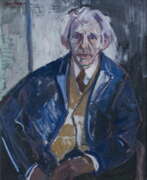

Tom Beyer is a German artist.
Beyer studied at the Düsseldorf School of Applied Arts, traveled throughout Europe, in 1931 opened a studio in Berlin and joined the Communist Party. Although the National Socialists who came to power in Germany in 1937 forbade him to exhibit, from 1939 to 1945 Beyer took part in World War II as a Wehrmacht soldier.
After the war, Beyer led an active social and artistic life. He was also a member of the Association of Visual Artists of the GDR and became its chairman in 1950. As a member of the SED, Beyer reflected in his works the socialist construction in his country, depicting nature and people. He created a large mural for the Löwenschen Saal hall in the Stralsund town hall. From 1972 he taught part-time at the Berlin-Weißensee School of Art.
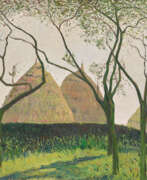

Julius Bretz was a German painter of the late nineteenth and first half of the twentieth centuries. He is known as a painter and graphic artist, a painter of landscapes and floral still lifes, a representative of the Düsseldorf and Hague Schools.
Julius Bretz was one of the four founders of the Düsseldorf art association Sonderbund and a founder of the Rhine Secession. He was also a member of the artist association "Malkasten" and a member of the Cologne and Bonn artist associations.
Bretz's paintings can be seen today in art museums in Bonn, Düsseldorf, Cologne, Wuppertal, Zurich and other cities
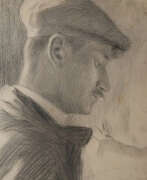

Georg Burmester was a German artist of the late 19th - first third of the 20th centuries. He is known as a painter, graphic artist, impressionist, representative of the Düsseldorf art school, and teacher.
Burmester worked mainly in the genres of landscape and marinas, but among his works there are also still lifes, as well as works in the genre of nude. He was a teacher at the Kassel Art School from 1912 to 1930 and was promoted to the rank of professor in 1917.
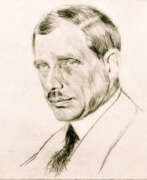

Max Clarenbach was a German painter of the first half of the twentieth century. He is known as a painter, landscape painter, genre painter and teacher and is considered one of the most important representatives of Rhenish painting of his time.
Max Clarenbach made study trips to Italy and Holland early in his career, where he formed his genre preferences and became a landscape painter. His work reflected the influence of the Hague School and the French Barbizonians. The artist skillfully depicted winter scenes and the nature of western Germany. He also painted sports and street scenes.
Clarenbach was one of the organizers of the Düsseldorf Sonderbund and taught at the Düsseldorf Academy of Art.
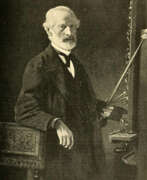

Hugo Crola was a German painter, son of the landscape artists Elise and Georg Heinrich Crola.
Hugo Crola studied at the Düsseldorf Academy of Art and later became a professor. He created images of many aristocratic and wealthy public figures, but is best known for his portraits of fellow artists.
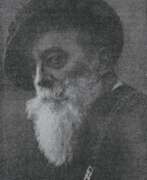

Eduard Adolf Daelen is a German artist, writer, and journalist.
He studied at the Düsseldorf Academy of Art and the Munich Academy of Fine Arts. Daelen was a member of the Malkasten Society of Artists (Malkasten) and was chairman of the local association Allgemeine Deutsche Kunstgenossenschaft. During World War I he took up drawing patriotic posters and war postcards.
Daelen also became known for the first biography of Wilhelm Busch, which he wrote in 1886. He also wrote art history articles that were published under pseudonyms in various newspapers.


Gustav Gildemeister was a German artist, a representative of the avant-garde movements of the early twentieth century.
He studied art at the Dusseldorf Academy, painted portraits and mainly landscapes in the styles that were actively developing at that time: German Art Nouveau, French Pointillism and late Impressionism. The artist was drafted during World War I and died at the front.
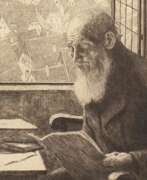

Franz Hecker was a German painter and graphic artist. He studied painting at the Dusseldorf Academy of Art and at the Académie Julian in Paris with William Adolphe Bouguereau.
Many of Franz Hecker's works focused on scenic motifs and Berzenbrück personalities and were inspired by Impressionism . In all, he created more than a thousand works in different techniques. He also painted murals in the conference rooms of the Berzenbrücke town hall. Some of Hecker's early works were considered "degenerate" by the Nazis, and in 1937 they were confiscated and destroyed.


Alfred Holler was a German painter of the first half of the twentieth century. He is known as a painter, graphic artist, printmaker, landscape painter and is considered a representative of Impressionist realism.
Holler created oil and watercolor paintings, woodcuts, charcoal and lead pencil drawings. In 1910 he moved to Belgium, where he worked and lived until the end of his life. Master for his work earned awards of Belgium: in 1934 - the Order of the Crown, in 1954 - the Order of Leopold II.


Carl Ernst Bernhard Jutz, also Carl Jutz der Jüngere was a German landscape painter of the Düsseldorf school of painting.
Jutz's landscape painting was founded in the romantic tradition of the Düsseldorf School and developed towards a broad Late Impressionist style. Painting with brightened, strongly luminous colouring. Atmospheric landscapes characterize his later work. A few animal paintings can also be found in his oeuvre.


Arthur Kampf was a German painter. He was associated with the Düsseldorf school of painting.
Kampf's work is most strongly associated with the genre of traditional history painting, though throughout his lifetime he explored styles influenced by Impressionism and Art Nouveau. He was also celebrated for large scale portrait work and in particular children's portraiture. Kampf also worked extensively as an illustrator, contributing drawings to volumes by Shakespeare (1925), R. Herzog, History of Prussia (1913) and J.W. Goethe, Faust (1925). Kampf's artwork post World War II largely focused on religious themes.


Josef Kolschein the Younger was a German painter, draughtsman and printmaker. He studied painting at the Düsseldorf Academy of Art in Eugen Dücker's landscape class.
Josef Kolshain the Younger advocated plein air painting and, influenced by French impressionism, sought a new colourful representation of landscapes. The artist followed this style throughout his career.


August Robert Ludwig Macke was an eminent German expressionist painter, founder and member of the Blue Rider association. His very colorful and individual style is today referred to as the Macke style, characterized by a harmonious combination of colors and the play of light effects. His favorite subjects of his works were sketches from the life of the city, as well as nature and man. The paintings of August Macke give an impression of joy and lightness.


Arvid Mather was a German impressionist and modernist painter, illustrator, and graphic artist.
He studied painting at the Düsseldorf Academy and belonged to Heinrich Nauen's circle. Mather participated in the exhibitions of Junges Rheinland as well as in the Rheinische Secession.


Julius Muller-Massdorf was a German portrait painter, genre painter, and illustrator.
He studied at the Düsseldorf Academy of Fine Arts and later became a professor. Muller-Massdorf painted interior, street, park, and beach scenes. He also worked as an illustrator for the press. In the later works of the artist there is a sense of the Impressionist trend.


Ludvig Munthe was a Norwegian-born, German landscape painter.
Munthe is associated with the Düsseldorf school of painting. A thoroughly realistic treatment characterizes his paintings, of which autumn and winter scenes in stormy or gloomy weather, forest and coast views form the prevailing subjects.


Eilert Adelsteen Normann was a Norwegian painter who worked in Berlin. He was a noted painter of landscapes of Norway. Normann was the artist who invited Edvard Munch to Berlin, where he painted The Scream. Normann's fjord paintings are credited with making the Norwegian fjords a more popular tourist destination.
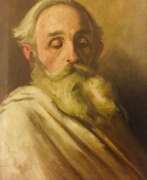

Wilhelm Schreuer was a German painter; associated with the Düsseldorfer Malerschule.
Most of his works were created with a distinctive technique, involving diluted colors on a damp surface, applied to glued paper; a method that makes major corrections almost impossible. The resulting surface is smooth as glass. Often, the effect is nearly monochromatic. Although he painted a wide variety of subjects, scenes from inns, restaurants, dance halls, and various events were obviously his favorites.
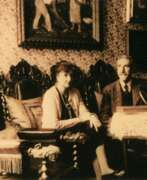

Max Stern was a German painter and graphic artist of Jewish ancestry, associated with the Düsseldorfer Malerschule. He was originally an Impressionist, but later became an advocate of the New Objectivity.
His career progressed uneventfully until the Nazi takeover in 1933. At that point, he was placed under a professional ban, and expelled from Malkasten. With the establishment of the Reichskulturkammer, it became difficult to obtain painting supplies. Despite this, he and his fellow Jewish artists in the Judische Kulturbund were able to exhibit among themselves until 1936. Shortly after that, in 1937, Joseph Goebbels ordered the confiscation of all "degenerate art", which included Stern's works.
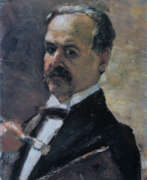

Lesser Ury was a German painter of the late nineteenth and first third of the twentieth centuries of Jewish origin. He is known as an impressionist painter, graphic artist and printmaker, a representative of the Düsseldorf school of painting.
Ury painted rural and urban landscapes, still lifes and monumental paintings on biblical themes. His works depicting the streets of Berlin and views of Brandenburg are particularly notable. Ury mastered both oil colors, creating floral paintings and urban scenes, and pastels, conveying an atmosphere of air and light in landscapes.


Fritz von Wille, real name Friedrich Gustav August Julius Philipp Rudolf von Wille is a German painter, member of the Malkasten group.
Fritz von Wille is known for his landscapes in the Impressionist style. To avoid confusion with his father, the painter August von Wille, he took a short name. His son Otto (1901-1977) also became a painter.


Paul Ernst Wilke was a German impressionist painter and marinist.
He studied at the Düsseldorf Academy of Art, as well as in Bremen and Berlin.
Wilke's paintings, influenced by Impressionism, were devoted to the North German coastal landscape and his beloved city of Bremerhaven.
